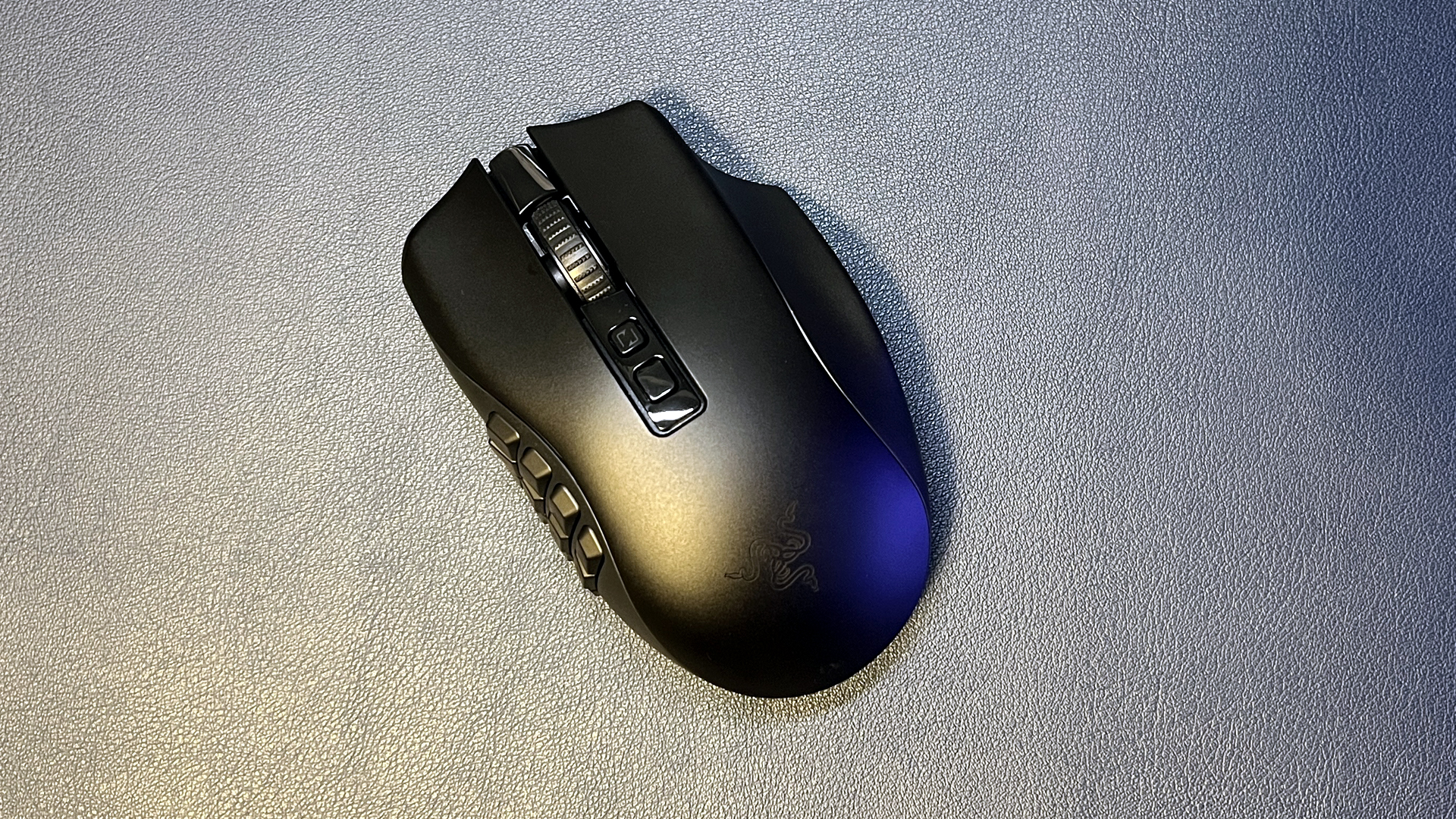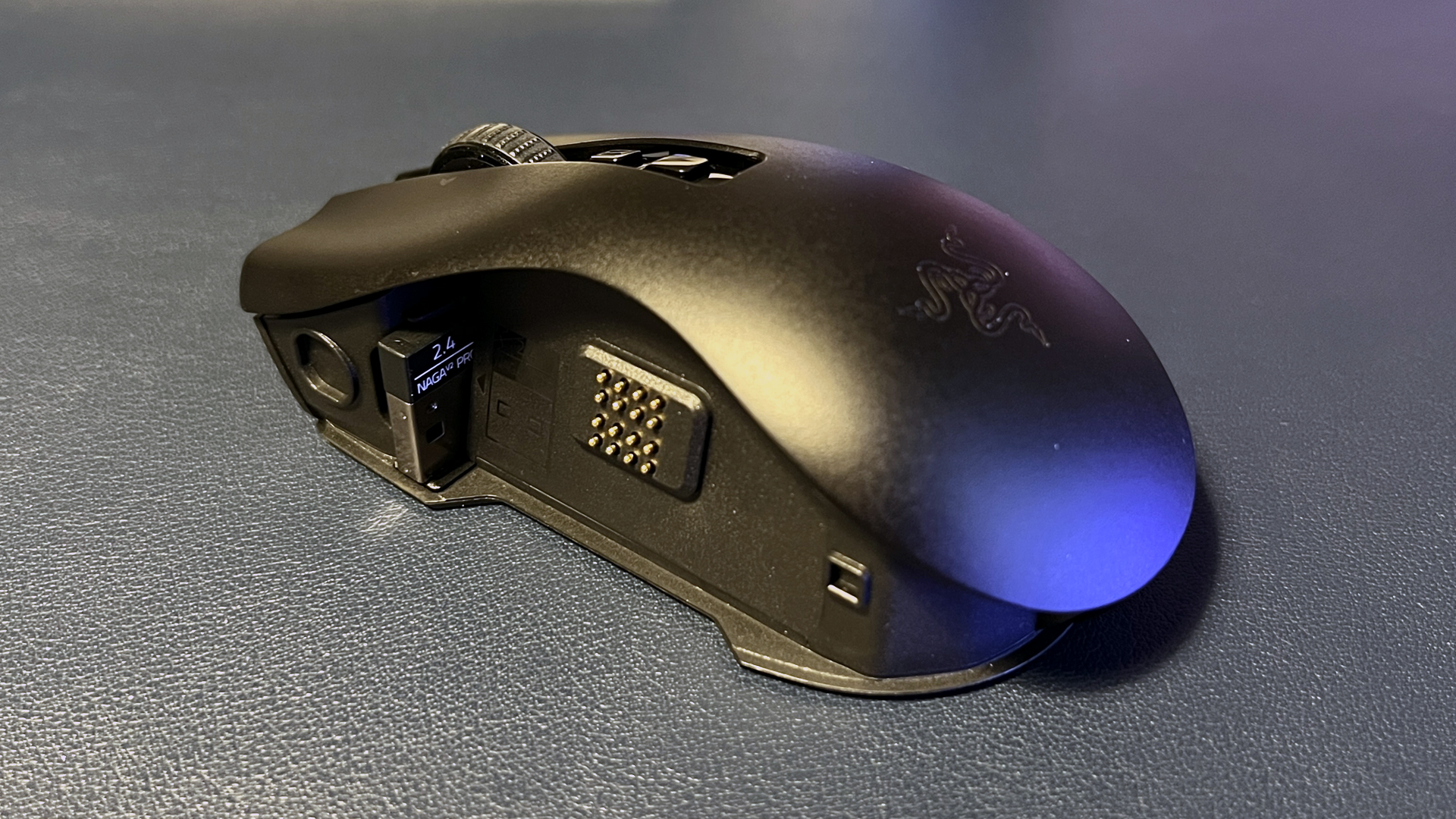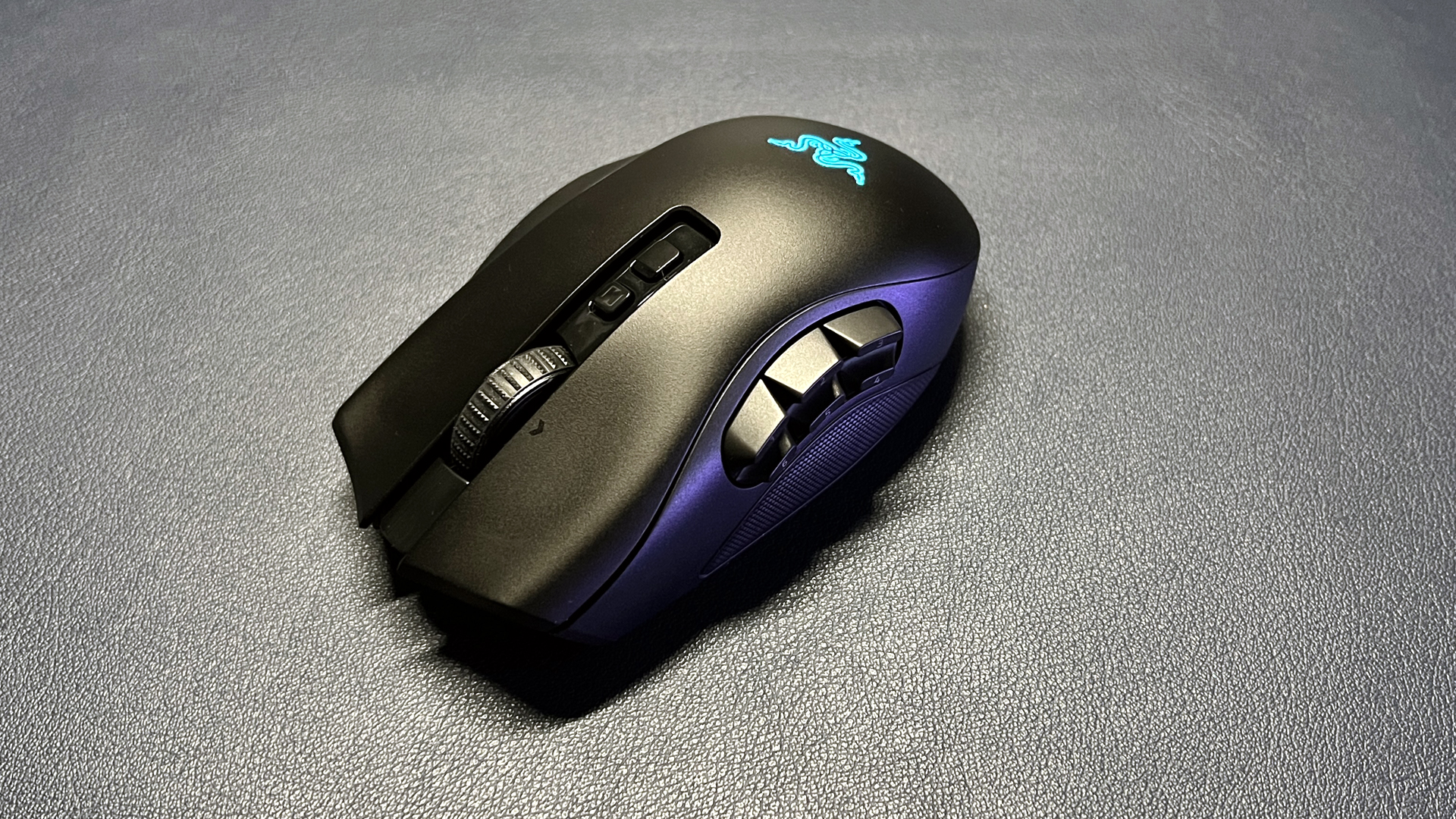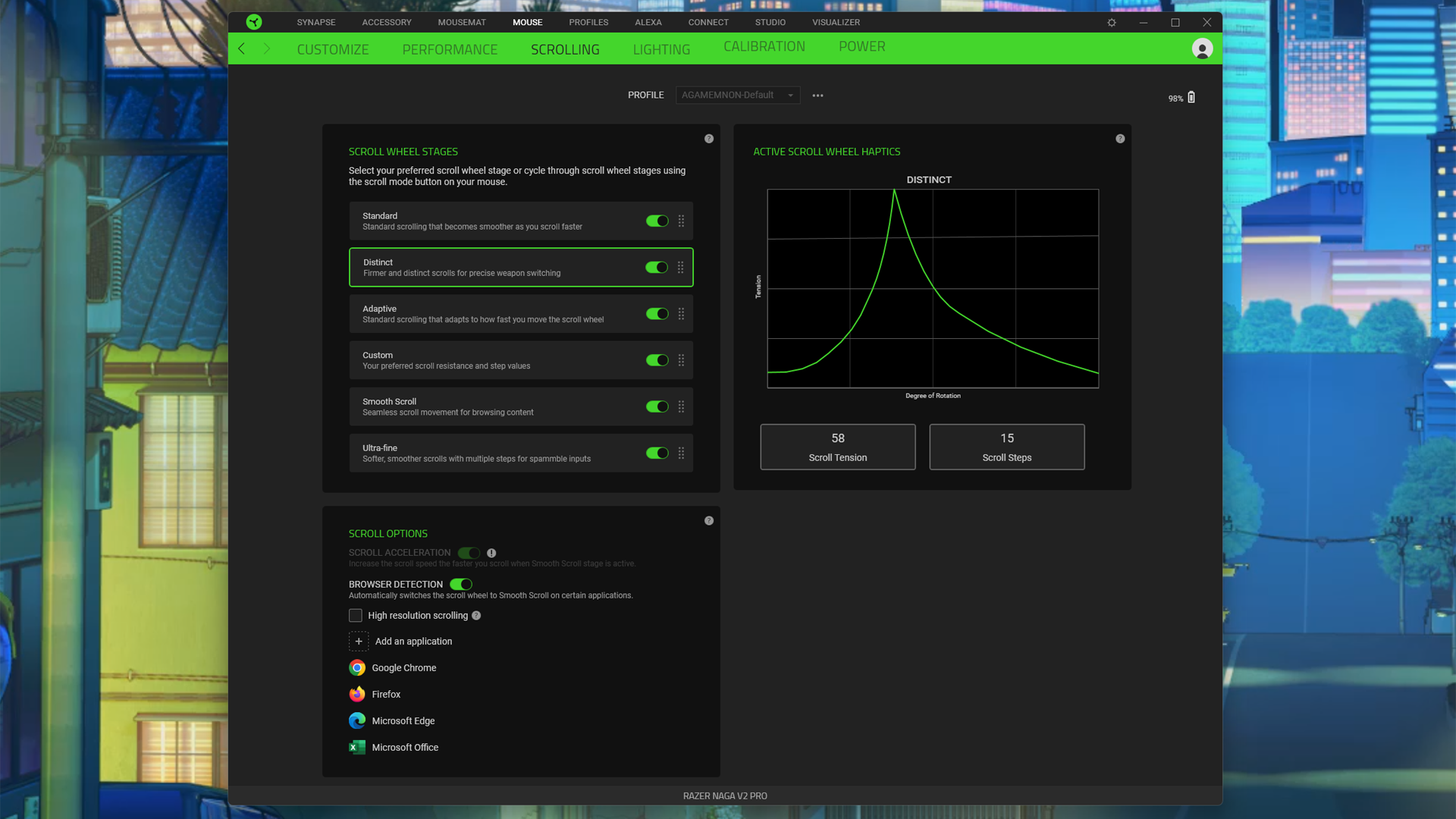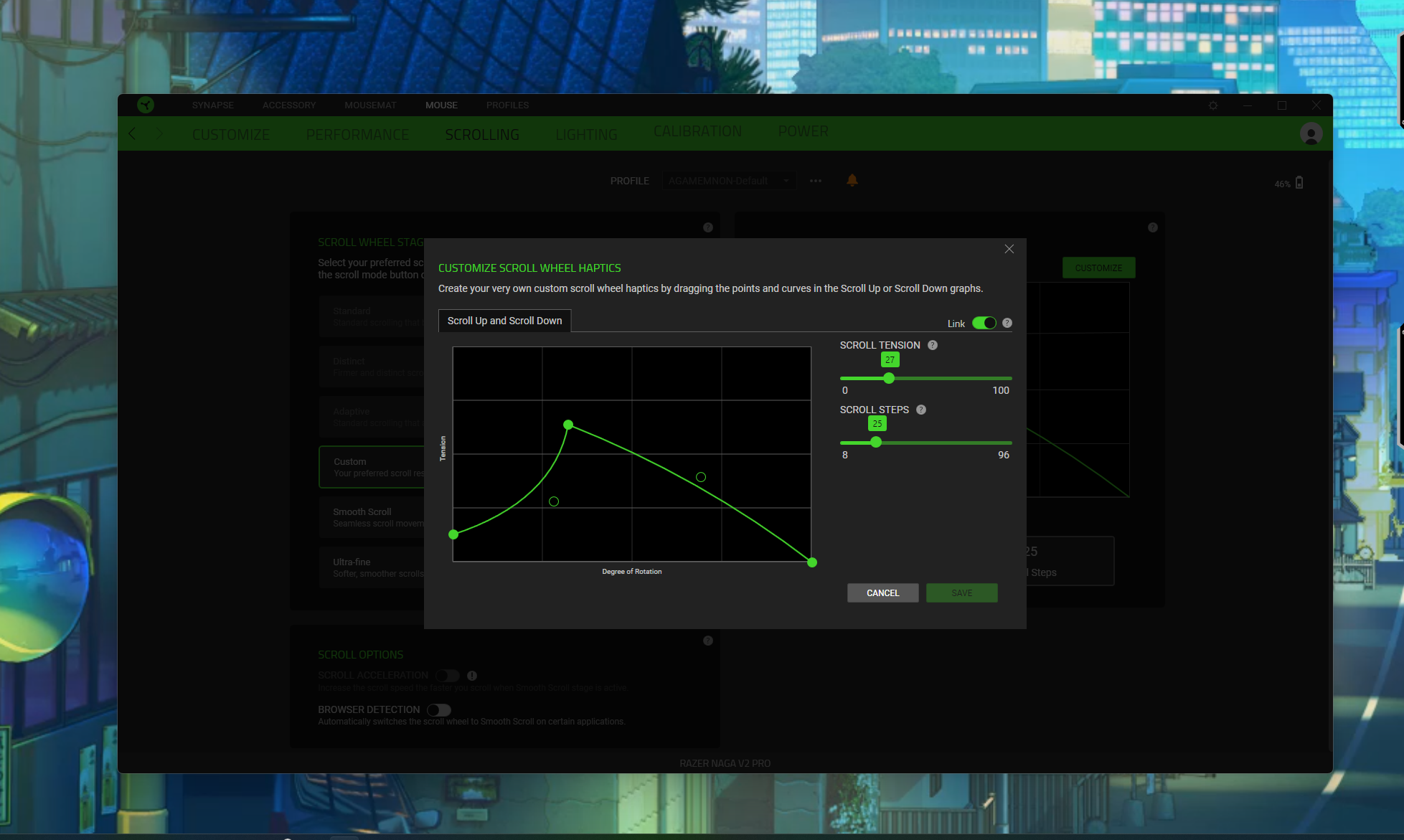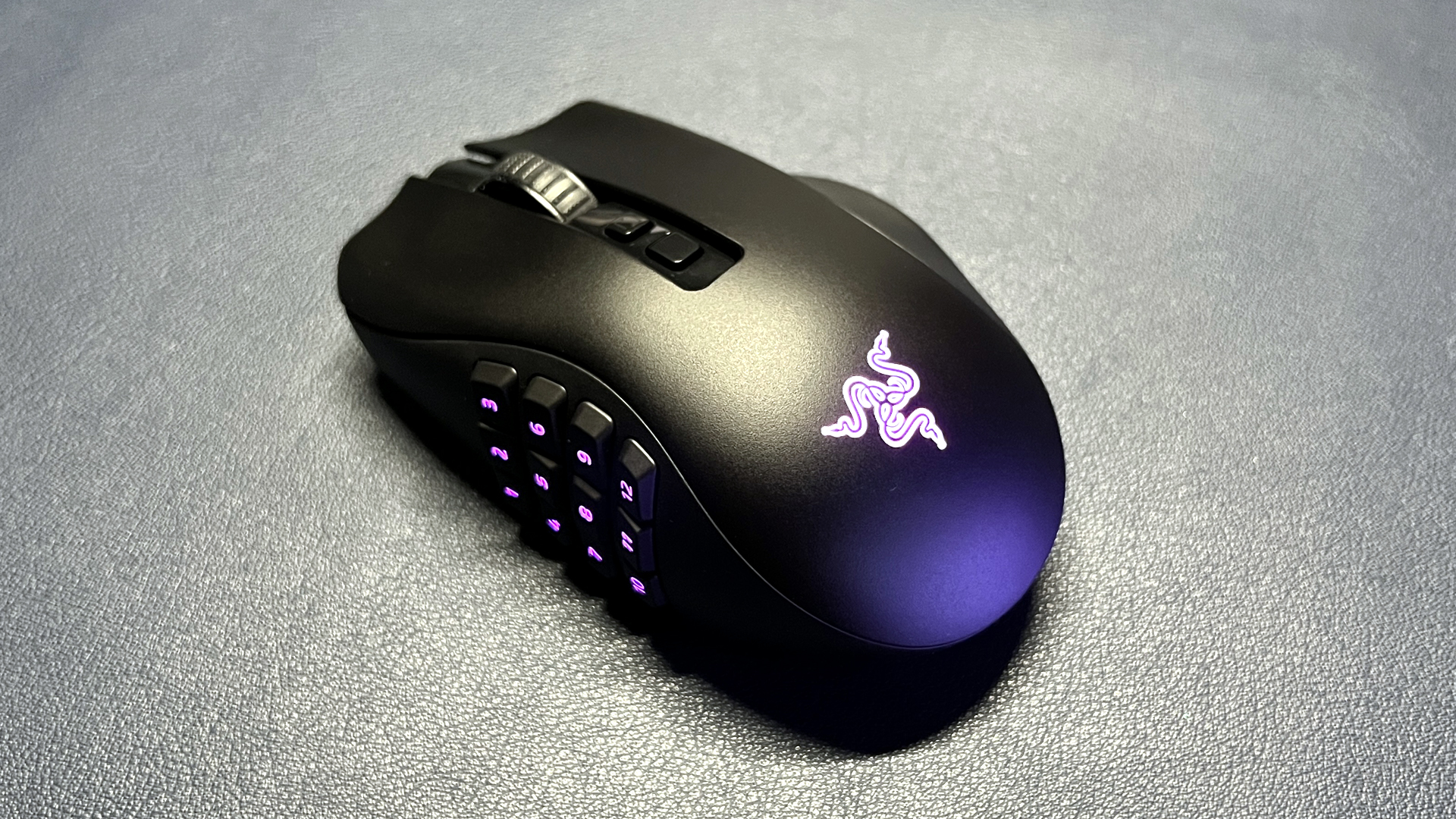Tom's Hardware Verdict
The Naga V2 Pro is highly customizable and incredibly versatile, and is also just an excellent all-around performer. But if you don’t need all of its features, there are cheaper options.
Pros
- +
Unique custom scroll wheel
- +
Swappable 12-, 6-, and 2-button side plates
- +
Excellent overall performance
- +
Comfortable
Cons
- -
Very expensive
- -
Heavy
Why you can trust Tom's Hardware
Razer’s been making minor — but impressive — updates to its gaming mice over the past year. But its MMO-focused Naga line has always been at or near the top of our list of best gaming mice for players of MMOs and MOBAs. And, ever since the introduction of the Razer Naga Trinity, it’s been one of the most versatile gaming mice, largely thanks to its interchangeable side plates.
So, where does Razer go from there?
Apparently, even more versatile: the new Razer Naga V2 Pro maintains its predecessor’s swappable side plates and adds in a uniquely customizable scroll wheel that lets users tweak scroll tension, number of scroll steps, and haptic feel. It’s wireless, with three connectivity options, and has an upgraded Focus Pro 30K optical sensor as well as the brand’s third-gen optical switches. It boasts up to 150 hours of battery life over 2.4GHz wireless (up to 300 hours over Bluetooth), and has up to 20 programmable buttons, including the three-click scroll wheel and the profile switch on the bottom of the mouse.
These impressive features and specs come at a cost, naturally: the Naga V2 Pro retails for $179.99 — and that’s just the mouse (no wireless charging dock or other accessories). That’s not to say the Naga V2 Pro isn’t worth it, because it absolutely is, if you need an incredibly versatile mouse. But does anyone actually need an incredibly versatile mouse?
Design and Comfort of the Naga V2 Pro
The Naga V2 Pro is a medium-sized wireless mouse with interchangeable side plates and a customizable scroll wheel. It doesn’t deviate much, design-wise, from the Razer Naga Pro (or the Razer Naga X); the Naga V2 Pro has the same right-handed, gently-sloped body as its predecessors, with a hump that’s closer to the rear of the mouse and a ridge on the right side for resting your ring finger. It’s housed in a plastic chassis with a smooth, matte black finish, and it has a textured panel on its right side (under the ring finger ridge).
I wasn’t floored by how comfortable the Naga V2 Pro was, but I did find it to be a very comfortable mouse, overall. I have medium-sized hands and relatively long fingers, and this mouse is on the larger side of medium (though it’s not as long as the DeathAdder V3 Pro or the Basilisk V3 Pro), measuring 4.7 x 2.97 x 1.72 inches (119.5 x 75.5 x 43.3mm). It weighs 4.72 ounces (134g), which is pretty heavy, even for an MMO/MOBA mouse — the Redragon M913 Impact Elite weighs 4.55 ounces (130g), the Corsair Scimitar RGB Elite weighs 4.3 ounces (122g), and Razer’s own Naga Pro weighs 4.12 ounces (116.5g). The extra weight didn’t bother me, but I’m a palm-gripper who prefers heavier mice.

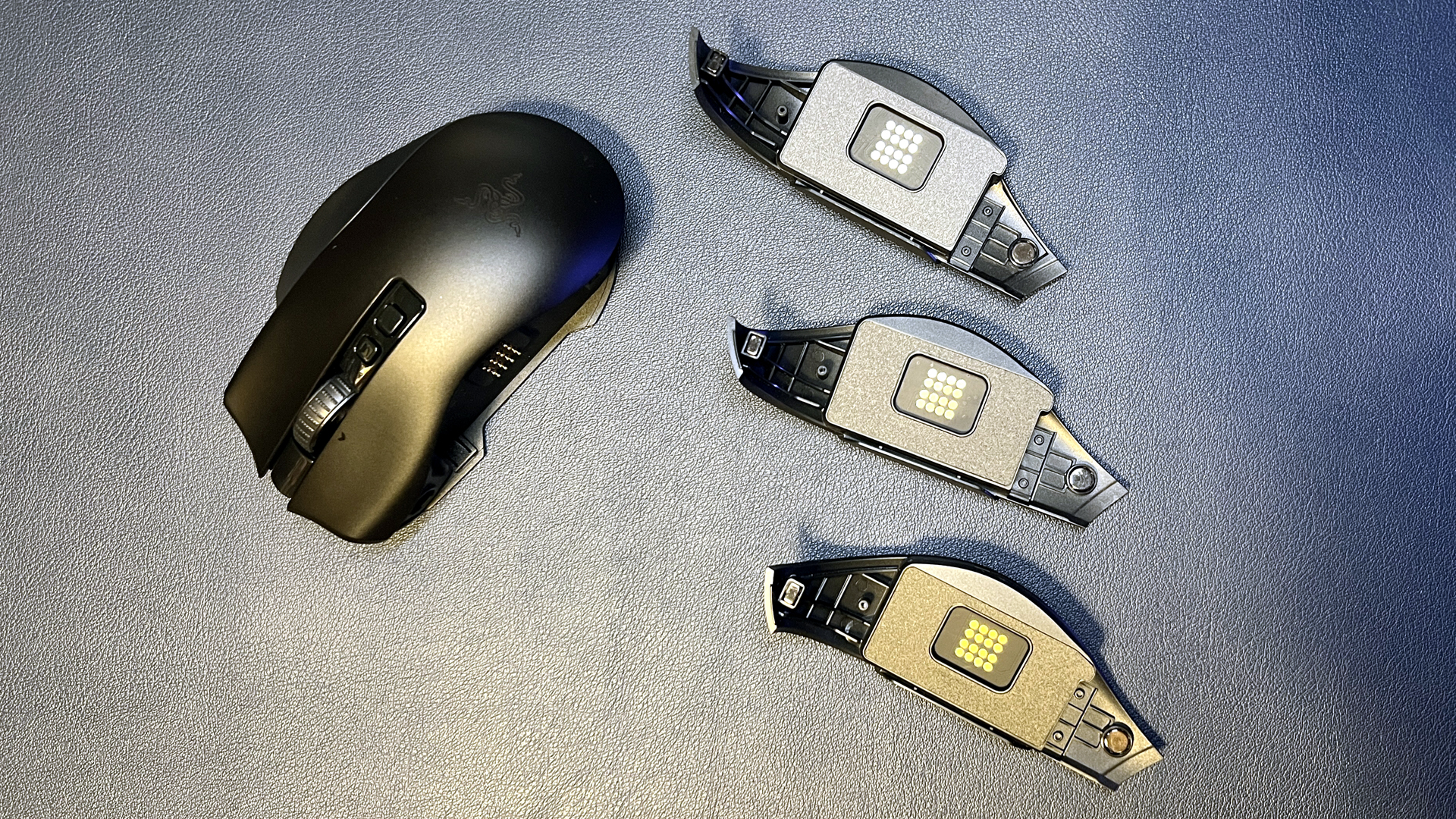
The Naga V2 Pro comes with three interchangeable side plates with 12, six, and two buttons. The side plates attach magnetically, which makes them very easy to swap out. The 12-button plate has numbered buttons with RGB, which can be customized in Razer’s Synapse 3 software. The six- and two-button plates do not have RGB, but do have textured panels for grip.
Get Tom's Hardware's best news and in-depth reviews, straight to your inbox.
There’s a small slot under side plates where you can store the mouse’s 2.4GHz wireless dongle when you’re not using it (e.g. if you connect through Bluetooth or the Razer Mouse Dock Pro).
The Naga V2 Pro also comes with a 2.4GHz wireless dongle, a 6-foot (1.8m) USB-C to USB-A Speedflex cable, and a USB extender.
On the bottom of the mouse you’ll find the power/connectivity switch, a profile change button, and a removable puck that can be replaced with the wireless charging puck from the Razer Mouse Dock Pro (sold separately). The profile change button can be reprogrammed in Razer’s Synapse 3 software. This gives the mouse a total of 10, 14, or 20 programmable buttons, including the three-way clickable scroll wheel (right, left, and regular click).
Specifications
| Sensor Model | Focus Pro 30K Optical Sensor |
| Max Sensitivity | 30,000 DPI |
| Max Speed (IPS) | 750 |
| Max Acceleration | 70g |
| Polling Rates | 125/500/1,000 Hz |
| Programmable Buttons | 10/14/20 (including 3-click scroll wheel) |
| LED Zones | 2 |
| Cable | 6-ft USB-C to USB-A, Razer Speedflex |
| Connectivity | 2.4GHz wireless, Bluetooth, wired (USB-C) |
| Measurements (L x W x H) | 4.7 x 2.97 x 1.72 inches / 119.5 x 75.5 x 43.5mm |
| Weight (excluding cable) | 4.72oz / 134g |
| MSRP | $179.99 |
Performance of the Naga V2 Pro
The Naga V2 Pro features Razer’s Focus Pro 30K optical sensor, which has a maximum sensitivity of 30,000 DPI, a maximum velocity of 750 IPS, and a maximum acceleration of 70g. It uses Razer’s gen-3 optical switches, which are rated for 90 million clicks (which is... plenty). All of the Naga V2 Pro’s buttons, including all 12 on the 12-button side plate, are well-placed and easy to press.
I tested the Naga V2 Pro with all three side plates in a variety of games, including an MMO (Elder Scrolls Online), a MOBA (League of Legends), a single-player FPS (The Callisto Protocol), and a competitive online FPS (Overwatch 2). The Naga V2 Pro performed well across the board — the sensor was accurate and precise, there was no noticeable click latency, and buttons offered just the right amount of tactile feedback.
While I didn’t mind the Naga V2 Pro’s heftiness overall, it was a little too heavy in both single-player and competitive first person shooters. In games where speed is top priority, an ultra-light mouse such as the DeathAdder V3 Pro is going to win for me, every time.
The Naga V2 Pro is semi-compatible with Razer’s Mouse Dock Pro ($70). It can connect through the Mouse Dock Pro (in lieu of its 2.4GHz dongle) and charge wirelessly. It cannot take advantage of the Mouse Dock Pro’s integrated 4K HyperPolling transceiver (nor is it compatible with Razer’s HyperPolling Wireless Dongle), and has a maximum polling rate of 1,000 Hz.
This isn’t really an issue, since polling rates above 1,000 Hz are mainly for speed-focused gamers at an elite, competitive level of play — and, as we’ve established, this is not really that kind of mouse in the first place. However, this is worth pointing out for anyone thinking of picking up the Mouse Dock Pro — wireless charging is all you’ll get. The Naga V2 Pro is also compatible with Razer’s Wireless Charging Puck, which can be purchased separately for $20 and works with any Qi-certified wireless charging device.
Features and Software of the Naga V2 Pro
You can configure the Naga V2 Pro using Razer’s Synapse 3 software. The main screen has a top-down mouse view, as well as side views for each of the three side plates; you do not need to have a specific side plate attached to program its buttons. All buttons, including the profile switch button on the bottom of the mouse, are programmable (with two layers of programmability via Razer’s HyperShift feature). The mouse has onboard memory with room to store up to five profiles.
In addition to button programming, you can also adjust the mouse’s DPI to be as detailed (or not) as you like. The mouse ships with five standard DPI stages (400 - 6400), which you can cycle through using the DPI switch button (second button under the scroll wheel). You can change these stages, remove steps, or enable different DPI settings for vertical (x-axis) and horizontal (y-axis) mouse movement.
Perhaps the most interesting feature of the Naga V2 Pro is its HyperScroll Pro scroll wheel, which has six different modes, including a user-adjusted custom mode. These modes range from “distinct,” which has high scroll tension and a lower number of scroll steps for firm, distinct scrolling; to “ultra-fine,” which has moderate scroll tension and a very high number of scroll steps for soft, but still tactile, scrolling; to “smooth scroll,” which has zero scroll tension for seamless, fluid movement.
You can rearrange the mode order, toggle modes on or off, and turn on options such as “browser detection,” which automatically switches the scroll mode to “smooth scroll” when you open browsers or other applications. You can also set up the custom scroll mode with your preferred scroll tension (0 - 100) and number of scroll steps (0 - 96), and adjust the way scrolling feels using the haptics graph.
There are other mice with scroll wheels that switch between notched/tactile scrolling and smooth scrolling, including Razer’s Basilisk V3 Pro, but the Naga V2 Pro’s customization is unique. The Naga V2 Pro’s scroll wheel modes are software-reliant, unlike the tactile/free-spinning scroll wheels on some of Logitech’s mice (including the G502 X Plus and the MX Master 3S), which are hardware-based.
Wireless Experience and Battery Life
The Naga V2 Pro offers three forms of connectivity: wireless (2.4GHz wireless and Bluetooth) and wired (USB-C). It comes with a 2.4GHz wireless USB-A dongle, as well as a six-foot USB-C to USB-A Razer Speedflex cable.
Razer says the Naga V2 Pro’s battery will last up to 150 hours with a 2.4-GHz wireless connection, and up to 300 hours with a Bluetooth connection. These numbers were clearly calculated with RGB lighting turned off: I initially used the mouse with the lighting on (and set to max brightness), and I was hitting 50% after a day’s worth of moderate use. But after I turned the lighting off, the mouse dropped from 100% to just 96% in the same amount of time.
Bottom Line
The Razer Naga V2 Pro’s interchangeable side plates and unique, multi-mode scroll wheel make it one of the most customizable mice on the market. It’s also spec'd out with Razer’s Focus Pro 30K sensor and 150+ hours of battery life, and its price reflects that. At $180, it’s one of the most expensive gaming mice on the market — and that number doesn’t even include a wireless charging dock (the $170 Roccat Kone XP Air comes with a dock).
The Naga V2 Pro is an excellent gaming mouse, but it’s packed with features many gamers may not need or use. How often do you really expect to swap side plates? My guess is not often — I can see occasionally swapping between two, but three? And while the Naga V2 Pro’s customizable scroll wheel is unique, it feels a bit unnecessary. All of the preset scroll modes (minus smooth scroll) were a little too stiff for me, so I spent most of my time swapping between smooth scroll and my custom (tactile) mode — I’d prefer a good two-mode setup to five or six unusable modes any day.
For MMO players who don’t need a mouse that can transform into a mouse that’s not for MMOs, Razer also launched the Naga V2 HyperSpeed ($99.99). The V2 HyperSpeed has the same form-factor and sensor as the V2 Pro, but it ditches the interchangeable plates for a fixed 12-button setup and the customizable HyperScroll Pro wheel for a regular HyperScroll wheel with two modes (tactile and free-spin). The V2 HyperSpeed is wireless and powered via battery (1x AA) for up to 250 hours over 2.4GHz wireless and up to 400 hours over Bluetooth.

Sarah Jacobsson Purewal is a senior editor at Tom's Hardware covering peripherals, software, and custom builds. You can find more of her work in PCWorld, Macworld, TechHive, CNET, Gizmodo, Tom's Guide, PC Gamer, Men's Health, Men's Fitness, SHAPE, Cosmopolitan, and just about everywhere else.
